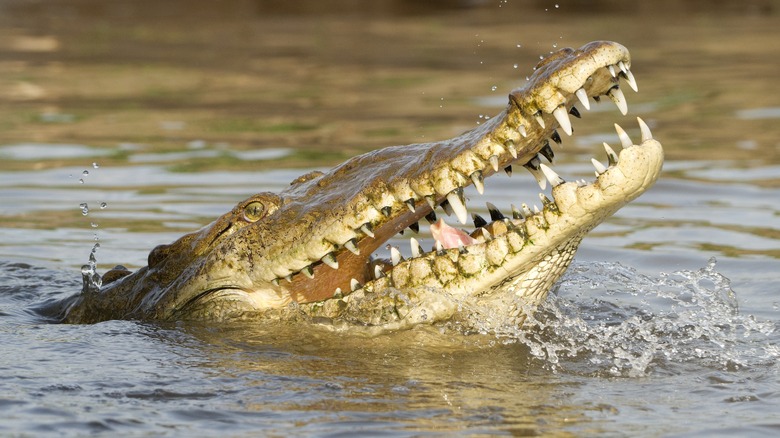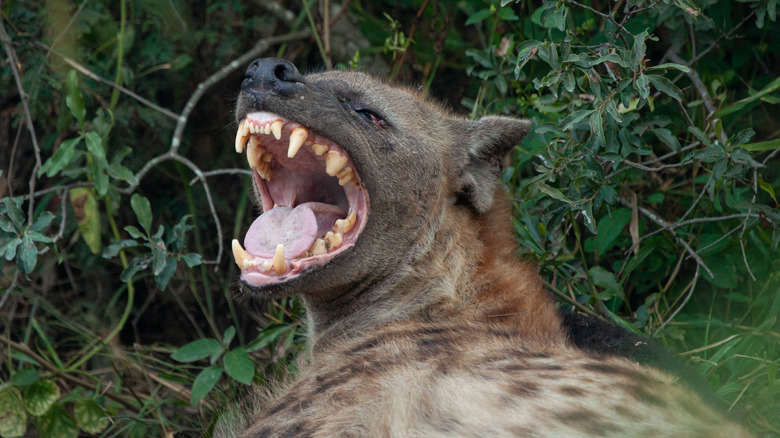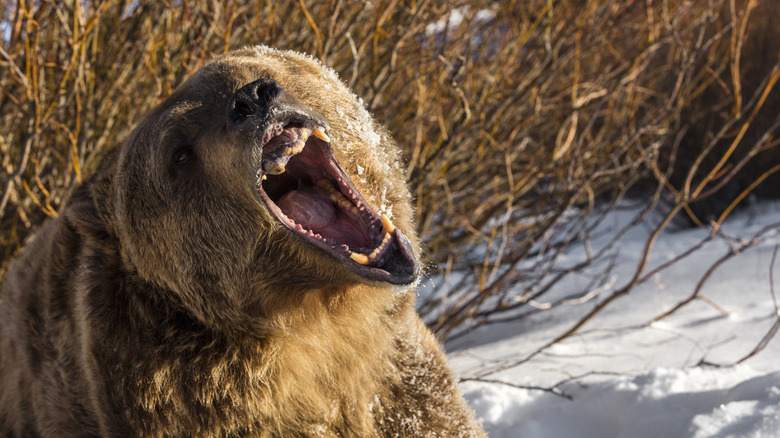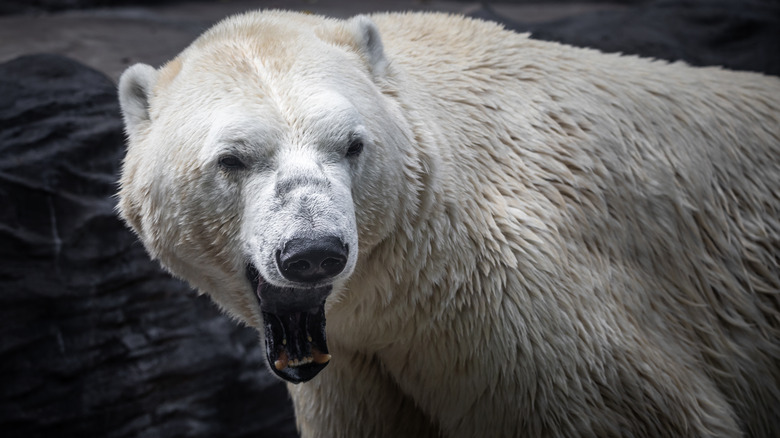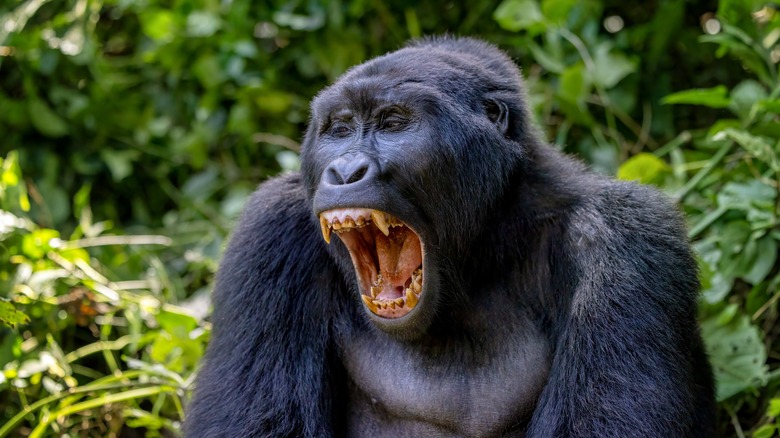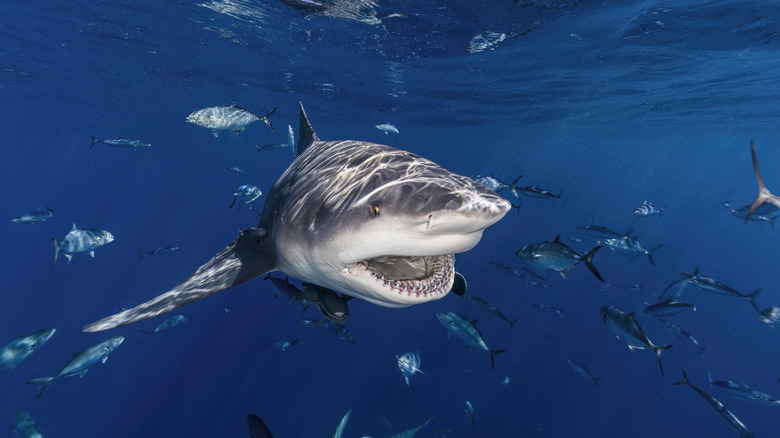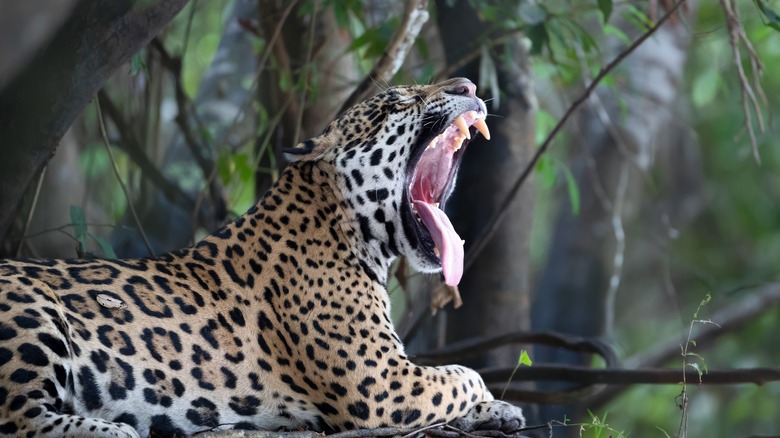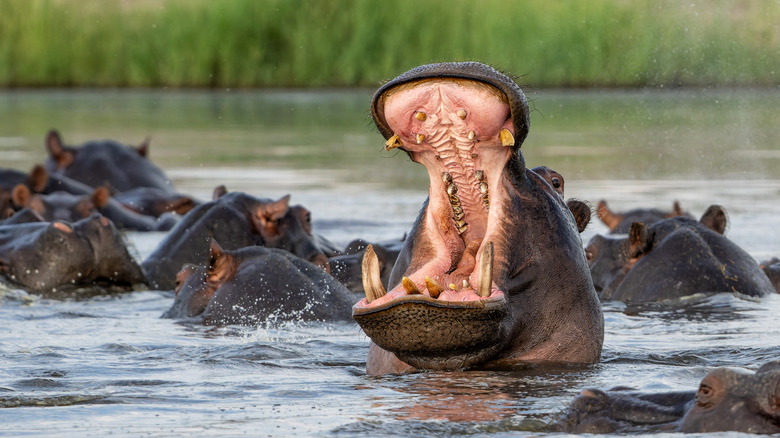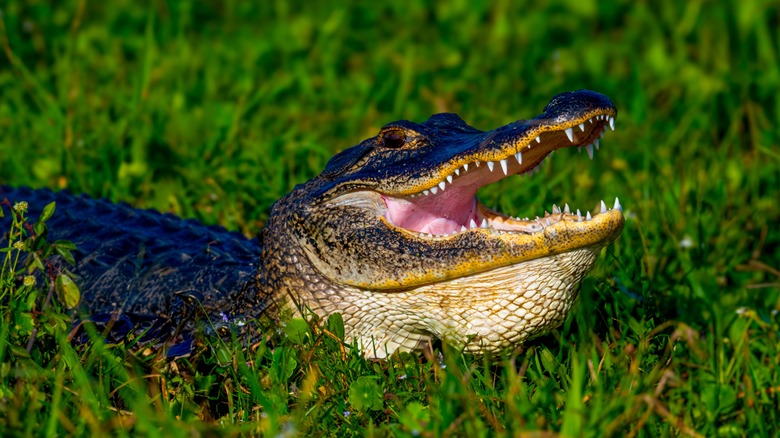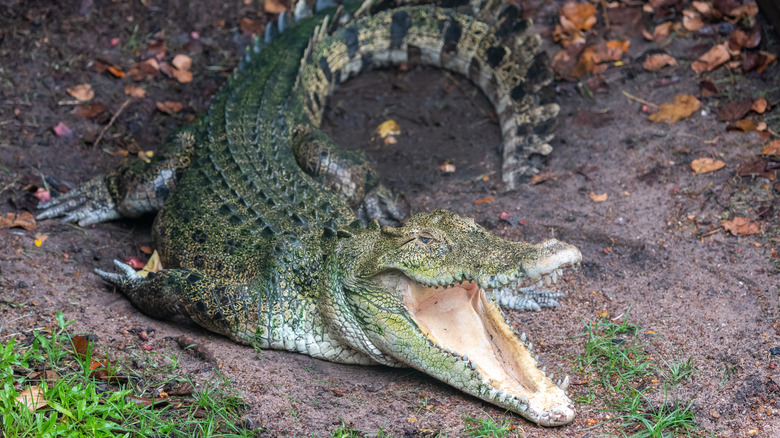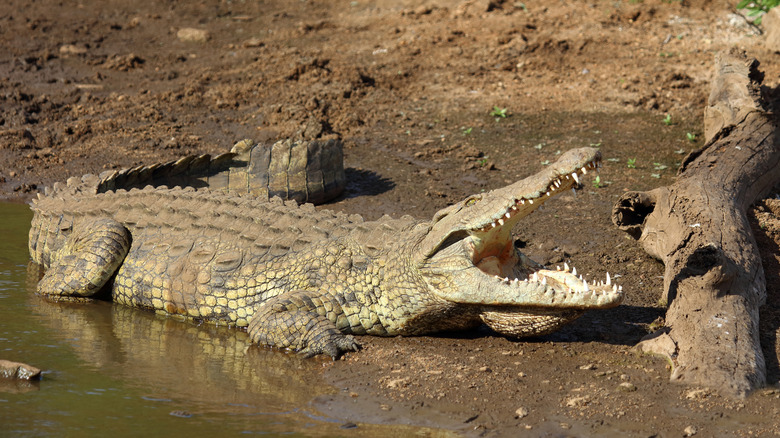10 Animals With The Strongest Bite Force Ranked
We discover strange new animal species every year. From prehistoric creatures that were pure nightmare fuel to venomous species that can kill you in minutes, the world has also seen its share of truly dangerous animals. Still, even among all these curious (and sometimes deadly) critters, there's a certain visceral horror in the simplicity of a powerful set of jaws, full of sharp teeth.
Bite force can be measured in a number of different ways. In 1681, Italian professor Giovanni Borelli built the first mechanical device for measuring human bite force. Most modern systems are electronic, with several prevailing options. Strain-gauge transducers measure the resistance change on a metal plate the subject bites. Piezoelectric transducers do the same with thin, easy-to-shape crystal foil sheets as the biting platform. Finally, pressure transducers are effectively elastic chew toys filled with fluid or air, connected to pressure sensors.
All of the above have issues. Getting the subject to chew a foreign object with full might is obviously a challenge. What's more, some animals' bite forces are difficult to measure, necessitating the use of 3D computer analysis. To complicate things further, several different units can be used to describe bite force, from Newtons and pounds of force to complex study-specific terms. Here, we'll use psi, a unit describing the animal's bite force in pounds of pressure per square inch. Armed with that and knowing the caveats of this particular field of science, let's take a look at the 10 strongest bites in the world!
Hyena
Thanks to pop culture works like Disney's "The Lion King," the hyena might enjoy a less than flattering reputation when you compare it to other animals that are carnivores. While it's true that they are scavengers who aren't above munching on carrion, it's just one part of the story. Hyenas are smart, adaptable creatures. The largest of them — the spotted hyenas, which can weigh up to 190 pounds — are all too happy to hunt prey when needs must, and have also been known to wreak havoc in human settlements while looking for food.
Another reason why the hyena is so formidable: When something gets bitten by one, it tends to stay bitten. A hyena boasts a bone-crunching 1,100 psi bite force – for comparison, a human's bite force is about 162 psi and a dog's bite force might hover somewhere around 250 psi. Combine the hyena's astounding bite with the animal's extremely strong shoulders and neck, and it is extremely well-equipped to bite through bones and flesh at its leisure. Oh, and to keep with "The Lion King" comparison: the lion's chompers can only generate between 650 and 1,000 psi of bite force, so on this front at least, the king of the jungle is at a distinct disadvantage against the supposedly lowly hyena.
Grizzly bear
Starting with its scientific name (Ursus arctos horribilis), the grizzly bear is a fearsome animal. This omnivorous predator can weigh over 800 pounds, and is just as likely to fish for salmon and prey on animals of all sizes as it is to forage for plants and insects. It's even happy to dine on dead, decomposing animals it might come across.
This "eat anything" philosophy and the animal's sheer size mean that the grizzly bear needs plenty of energy, and has to be equipped for just about every feeding situation that might come its way. Its powerful muscles and a surprising turn of speed make it a powerful and deceptively quick animal, and its big, sharp claws make for an all-purpose tool that's suitable for digging, grabbing, and clawing alike.
Complementing these powerful traits is, of course, an extremely strong bite. The grizzly bear hangs around the top of the wilderness food chain with a bite force that, depending on the source, can be anywhere from 975 to 1,160 psi. While the lower range would put the grizzly below the hyena in terms of biting power, there's a fairly large variability within grizzly bear sizes — and, based on the psi variance, their biting power. Since 1,000 psi seems to be the hyena's bite power ceiling and reports of stronger grizzly bites existing, it seems fair to say that the grizzly wins this particular contest between the two animals.
Polar bear
The largest living bear today may be nothing compared to prehistoric nightmares, but the polar bear is still a sight to behold ... and, unless you have a very vivid imagination, it's effectively a supersized version of everything you thought you knew about bears. The apex predator of the arctic region can be over 11 feet tall while standing on two legs, and large specimens can weigh over 1,700 pounds. This size means that polar bears need quite a bit of food to survive, and because their habitat has little in the way of vegetation, they're carnivores that eat whatever they can sink their teeth and claws into.
Seals are a massively important food source in the incredibly challenging environment the largest carnivore in the world operates in. Because of this, the polar bear often tries to locate ringed seals' breathing holes on the ice. In a grim, high-stakes game of Whack-a-Mole, the bear's next meal (and, conversely, the seal's life) can depend on how well it can catch its prey when it comes up to take a breather.
As it happens, the polar bear has a very handy tool for these particular occasions, as well as many others. Thanks to a bite force of around 1,200 psi, the polar bear is the ursine with the strongest bite. Thanks to this, there are few seals (or anything else, for that matter) that are going to escape after the massive predator sinks its teeth in them with intent.
Gorilla
The gorilla, with its up to 6-foot, 440-pound frame, is without doubt dangerous — that's the whole point of the "100 men versus one gorilla" meme-slash-thought experiment you may have encountered. It's a powerful animal, and if it sees something as a threat, it can be a mighty adversary.
However, one thing gorillas decidedly (and thankfully) are not is carnivores. As such, their horrid jaws and teeth that boast an impressive bite force of 1,300 psi might seemingly make them the odd ape out on this list ... if it wasn't for the fact that there's a very good reason for such a mighty bite.
Sure, the gorilla will flash its massive teeth to communicate — mere baring of teeth is a submissive gesture, while an outright yawn indicates dominance or serves as a warning. However, when a gorilla fights or attacks, its powerful bite is usually not in play at all. Instead, the gorilla's bite force is necessitated by the animal's diet, which might not require biting through bones, but isn't any less labor-intensive for the jaws. A gorilla can eat as much as 40 pounds of food on a daily basis, and a significant part of its diet consists of tough vegetation that will require a set of truly sturdy chompers. This is especially important when a gorilla wants to munch on termites or ants: It can simply bite a tree to access the insects lurking within.
Bull shark
Is any list of powerful bites complete without at least one shark representing the Selachii division of predatory marine animals? The shark you'd expect to see here is the big gun of the shark world, the great white shark. However, this is a great example of the trickiness of measuring bite forces: Sometimes, the smaller guy packs a stronger bite ... at least in official books.
Bull sharks develop powerful jaws very young in order to catch and hold on to sizeable prey. This gives them a bite force that can be up to 1,350 psi. Meanwhile, the bite force figure floating around for the great white is "just" 625 psi – but in actuality, this has never been accurately measured.
There are caveats, as you'd expect. Bull sharks are up to 11 feet long and weigh somewhere between 200 and 500 pounds. Meanwhile, great whites can be up to 20 feet long and weigh some 5,000 pounds. As such, even if we accept that a bull shark's bite force per square inch is technically superior, the sheer size of larger great whites will still make their bite the nastier overall experience. Besides, some researchers have posited that great whites could have the highest bite force of all animals, but since this theory only has computer analysis to back it up, we'll let the bull shark have its day in the spotlight ... at least, until some foolhardy researcher proves otherwise.
Jaguar
A more airtight example of the smaller animal packing more bite than its larger siblings is the jaguar, which actually holds a Guinness World Record for the highest bite force in a big cat relative to body size. Yes, when it comes to sheer pound-for-pound, pressure-per-inch bite force, lions and tigers can't hold a torch to the jaguar and its record-worthy jaws that can produce a bite force of 1,500 psi.
The jaguar needs its bite, too. While the feline predator enjoys munching on mammalian prey like its larger relatives, it can and is fully willing to make a quick lunch out of turtles and thick-skinned crocodiles, as well. What's more, the jaguar's bite allows it to hunt in a way other big cats wouldn't dare attempt: It simply bites the prey animal's skull, crushing it with its jaws.
The jaguar's most obvious big cat competitors aren't exactly losers on the biting department themselves, either. As mentioned earlier, a lion's bite force is about 650 psi and can potentially be up to 1,000 psi. A Siberian tiger can bite with a force of up to 950 psi, and the Bengal tiger can reach nigh-Hyena bite force levels of 1,050 psi. As such, the big cats are a category where pretty much every bite is a losing ticket.
Hippopotamus
The hippopotamus is a particularly frightening entry on this list, both in terms of size and bite force ... not to mention the reason behind said bite force. The thing is, the hippopotamus diet doesn't include any meat. Instead, a hippo eats grass, weeds, and other plants that really, really don't require its mouth to open 150 degrees into a 4 or 5-feet-tall, 2-feet-wide maw that's filled with terrifyingly large teeth that can bite down with the force of 1,800 psi. For the hippopotamus, that gaping mouth and its powerful bite are weapons, plain and simple.
A hippo may look cute from a distance, but you really don't want to get close to one. A large specimen can be up to 16.5 feet long and weigh over 9,900 pounds, and people who think that makes them lumbering, overweight animals are in for a surprise. They're surprisingly quick and extremely strong, and they're lethally aggressive if a perceived threat ventures into their territory — or even when it's time to physically fight another hippo during the mating season.
In either case, the hippo's bite force and sharp 20-inch canine teeth become a major weapon, which they very much use even on humans: While there's no real way of knowing just how many people hippos fatally attack annually, the ballpark figure could be anywhere between 500 and 3,000. Together with its size and power, this aggression makes the hippopotamus the most dangerous large land mammal in the world.
American alligator
Readers who are familiar with crocodiles and alligators may have suspected that these cold-blooded predators would dominate the highest rankings of this list. Kicking off the top three is none other than the American alligator, which can be over 12 feet long and weighs up to 1,000 pounds. The American alligator attacks and feeds on pretty much whatever it can catch, including turtles. Since it might attempt to bite into just about anything it can reach, it needs powerful jaws — which, thanks to a huge mouth with a 2,125 psi bite force, it very much has.
It can be hard to imagine how such a crushing bite force would feel like. Fortunately, Professor Greg Erickson of Florida State University — who recorded the American alligator's psi bite force together with zoologist Greg Vliet — has come up with a simple way to illustrate just how powerful an alligator's jaws can be. "If you were in the jaws of an alligator and trying to get out, it would be like trying to lift a pickup truck off of yourself," Erickson said in a press release (via Science Daily). "It isn't going to happen."
Erickson also elaborated on the art of measuring bite force by getting grumpy gators to bite a pole fitted with sensors. "It was really dangerous," he said. "This was a case where you had to do a lot of delicate electronic measurements on some pretty unwilling subjects."
Saltwater crocodile
The saltwater crocodile was the winner of a wide-spanning 2012 bite force study. With a measured bite force of 3,700 psi, this gigantic animal — which is also known as the estuarine crocodile — can rely on its jaws while hunting for dinner. This is bad news for everything around it, considering the saltwater crocodile's status as the world's largest reptile that can grow over 23 feet long and weigh up to 2,650 pounds.
As nightmarish bite experiences go, the saltwater crocodile isn't limited to just pure bite force and physical size. It hunts by night, and it prefers to attack its victims with a quick burst from underwater, pulling the poor prey under to drown it and, quite possibly, treating it to the signature move of alligators and crocodiles: A gruesome death roll where the predator clamps an animal with its teeth and rolls rapidly, with the forces involved quite literally tearing the poor prey apart.
As if all of this wasn't enough, the saltwater crocodile isn't picky about what it eats at all. Its size and powerful jaws enable it to capture animals of any sizes, from small crabs to massive buffalo ... or, if the opportunity presents itself, other saltwater crocodiles. Thanks to its highly aggressive and territorial nature, humans are also far from safe from this colossal animal.
Nile crocodile
So, how does the Nile crocodile — Africa's answer to Asia and Australia's fearsome saltwater crocodile — get one over the winner of the aforementioned 2012 bite force comparison study? By biting really hard, naturally, but this one may still be a bit of a technicality. The Nile crocodile has a measured bite that can go up to 5,000 psi. However, estimates of the animal's bite force vary, and this impressive number may be based on a single field test by Dr. Brady Barr, which gave an adult Nile crocodile's bite force as 5,000 lbf/in2 (an alternate symbol for psi).
On average, Nile crocodiles are smaller and weaker than saltwater crocodiles: 12 to 16 feet, some 500 pounds. They have a similar "anything goes" diet as their larger cousin and can even attack smaller hippos. They're also very dangerous to humans, and have been estimated to kill up to 200 people every year.
Individual Nile crocodiles can grow very large, though. The infamous Gustave — a man-eating specimen in Lake Tanganyika that has reportedly killed over 300 people — is reportedly at least 20 feet long and weighs over 2,000 pounds, which implies a fairly large variance within Nile crocodiles. As such, it seems reasonable to assume that the average saltwater crocodile may bite harder than the average Nile one, but individual specimens (like, perhaps, the one Dr. Barr measured) may be able to bite down with unsurpassed force, thus winning the day for the Nile crocodile.
